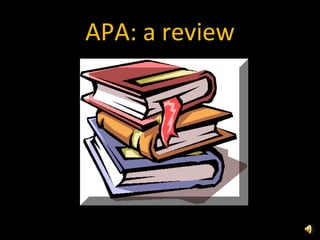
Apa review with voice over
- 2. When in text referencing – but not direct quote Type the information in your own words (author, year). In fact, the Internet changed the face of education in the 1990’s and facilitated a boom of online learning (Casey, 2008). Or when using the author’s name in your paper, follow name with (year) and his/her point in your own words: Certo (2010) explained the need for documentation as a means for ……..
- 3. Direct Quote, in text: Place quote in quotation marks, follow with (name, year, p. __). Note the punctuation – placement of the period follows the closing parenthesis. “The concept of hybridization [is] the bringing together of two dissimilar parts to produce a third result” (Vaughan, 2007, p. 82).
- 4. Quote from personal communication/interview Follow the direct quote (be sure it is in quotation marks) or paraphrase by (Last Name, personal communication, date of communication). The days of fifteen weeks of lecture are long gone as a facilitative approach is becoming a sound replacement to lecture-style teaching (Boland, personal communication, June 9, 2010).
- 5. Multiple Authors: Two authors in text vs. two authors in parentheses: When mentioning two authors in a sentence, write them as Allen and Seaman (2010) …… When referencing them in parenthesis, it is (Allen & Seaman, 2010)….. A Work by Three to Five Authors: List all the authors in the signal phrase or in parentheses the first time you cite the source. Such as: (Kernis, Cornell, Sun, Berry, & Harlow, 1993) In subsequent citations, only use the first author's last name followed by "et al." in the signal phrase or in parentheses. (Kernis et al., 1993)
- 6. Block Quote – 40+ words …The current college student grew up on the cusp of technology, so various technological levels of comfort exist (personal communication, June 9, 2010). CDW-G Report (2010) echoed Boland’s assertion when they reported: 63% of current college students say technology on campus was important in their college selection criteria; 93% of today’s high school students say campus technology is important in their college selection criteria; [and] 95% of today’s high school students expect to use technology in college during all or some classes. (p. 3) Despite these findings, higher education cannot rely strictly on the use of technology to ensure learning. Pay attention to the punctuation – it is different for block quotes.
- 7. Citing Indirect Sources If you use a source that was cited in another source, name the original source in your signal phrase. List the secondary source in your reference list and include the secondary source in the parentheses. Johnson argued that...(as cited in Smith, 2003, p. 102).
- 8. Two or More Works in the Same Parentheses: When your parenthetical citation includes two or more works, order them the same way they appear in the reference list, separated by a semi-colon. (Berndt, 2002; Harlow, 1983)
- 9. Reference List Take notice of: • Capitalization of article titles, journal titles, book titles • Note punctuation • Note use of italics • When possible, include the doi number • Alignment – CTRL T
- 10. Examples Delialioglu, O., & Yildirim, Z. (2007). Design and development of a technology enhanced hybrid instruction based on MOLTA model: Its effectiveness in comparison to traditional instruction. Computers & Education, 51(1), 474-483. doi:10.1016/j.compedu.2007.06.006 Dukes III, L., Koorland, M., & Scott, S. (2009). Making Blended Instruction Better: Integrating the Principles of Universal Design for Instruction into Course Design and Delivery. Action in Teacher Education, 31(1), 38-48. Dukes III, L., Waring, S., & Koorland, M. (2006). The blended course delivery method: The not-so-distant education. Journal of Computing in Teacher Education, 22(4), 153-158. Garnham, C. & Kaleta, R. (2002). Introduction to hybrid courses. Teaching with Technology Today, 8(6). Retrieved from http://www.uwsa.edu/ttt/articles/garnham.htm. Garrison, D. R. & Vaughan, N. D. (2008). Blended Learning in Higher Education. San Francisco: Jossey-Bass.
- 11. Any APA Related Questions?